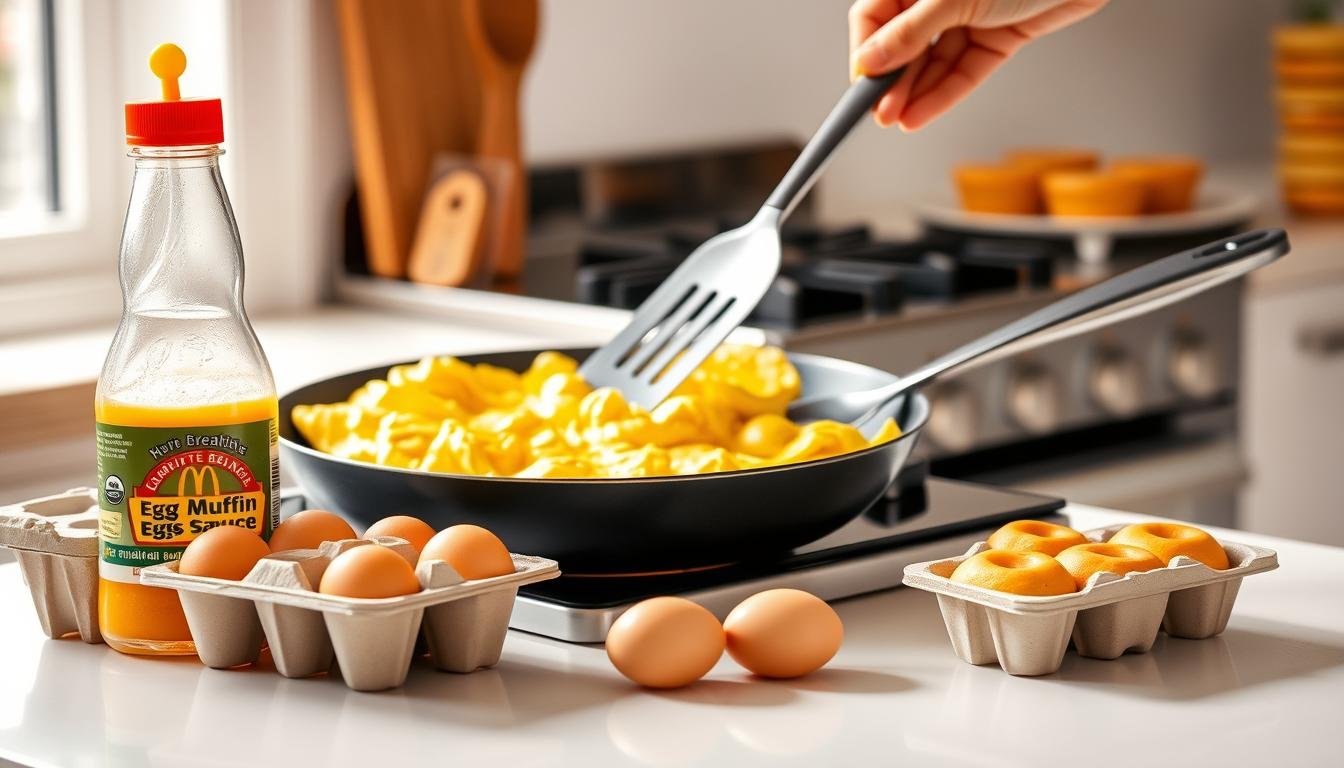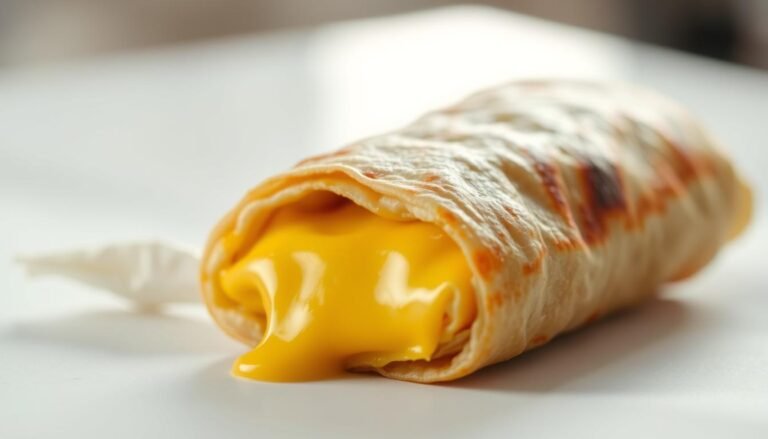Master How to Make McDonald’s Eggs at Home
Want to taste McDonald’s eggs without leaving home? This guide will teach you how to make McDonald’s eggs at home. Enjoy fast-food style eggs for sandwiches and breakfast any time.
Busy families and commuters who miss their morning orders will love this. Home cooks looking for a fresher, customizable option will also find it useful. Whether you prefer quick microwave hacks or stovetop precision, we aim for reliable results that match the originals.
Discover why homemade McDonald’s eggs might not always hit the mark. Learn the exact ingredients and tools needed. Follow our step-by-step stovetop and microwave methods. Plus, find out how to make a copycat McDonald’s egg muffin, scrambled variations, and advanced texture tricks.
Get time-saving make-ahead tips and nutrition swaps for special diets. Our goal is to give you practical tips for a perfect breakfast every time.
Key Takeaways
- Learn clear steps for how to make mcdonald’s eggs that match fast-food texture and shape.
- Find both stovetop and microwave methods for quick mornings or precise cooking.
- Get exact ingredient amounts and simple tools to form round, uniform eggs.
- Use shaping and timing tips to avoid rubbery eggs and achieve consistent results.
- Discover make-ahead, reheating, and healthier swap ideas for everyday breakfasts.
how to make mcdonald’s eggs
McDonald’s eggs are known for their calm and predictable taste. Home cooks can easily make them by following a few steps. The goal is to achieve a round or folded egg that’s tender yet fully cooked.
They should have a mild savory taste and a custardy feel. The color should be pale yellow.
Overview of the signature texture and flavor
The secret to their texture is portion control and gentle heat. Fast-food kitchens use steam and ring molds to cook eggs that are soft but not runny. This method adds moisture, making the eggs light and custardy.
Mild seasoning keeps the taste appealing to many. It’s not too strong or overpowering.
Why home versions often miss the mark
At home, the common mistakes are overcooking and uneven thickness. High heat can make the edges brown and the centers rubbery. Using the wrong pan or skipping molds can result in odd shapes and uneven cooking.
Less precise timing and no steam can also make eggs dry. This is because steam helps keep them moist.
Key ingredients and techniques that replicate the fast-food result
Begin with large, fresh eggs. Add a tablespoon of water or milk to each egg to get that custardy texture. Cook them over low heat with a lid on or use a microwave-safe ramekin for short bursts to trap steam.
Use nonstick pans, silicone egg rings, and biscuit cutters to form even rounds. This will help you achieve McDonald’s style eggs at home.
Understanding McDonald’s egg style and what makes it unique
McDonald’s eggs are known for their consistent texture. They are moist and even, with little browning. This is due to cooking with steam or gentle heat, not high-heat frying.
Steam vs. pan-cooked characteristics
Steam-cooked eggs are tender and uniform. Commercial kitchens use steam to avoid crisp edges. This method ensures a soft set every time.
Pan-cooked eggs, on the other hand, brown faster. They can develop crisp rims unless you slow the heat and trap steam under a lid.
Microwave cooking in covered ramekins or silicone molds mimics steam. This method gives a similar moist set without complex equipment.
Role of seasoning and milk/water in texture
Salt is the main seasoning in fast-food eggs. A lightly seasoned egg pairs well with cheese, sausage, or bacon. Adding 1 teaspoon of water per egg before cooking encourages tiny steam pockets that soften the crumb.
Using milk or cream makes eggs richer and slightly creamier. Butter adds flavor and prevents sticking. Nonstick spray works well for molds when making mcdonald’s inspired eggs.
Why shape and thickness matter for sandwiches
Round, even eggs fit English muffins and McMuffin-style sandwiches perfectly. Aim for a thickness of 3/8 to 1/2 inch. This ensures each bite balances egg, cheese, and bread.
Uniform thickness means predictable cook times and even reheating. When making mcdonald’s style eggs for batch cooking, consistent shape ensures the same tender texture across every sandwich.
Essential ingredients for homemade McDonald’s style eggs
To make a copycat McDonald’s eggs at home, start with the basics. Then, pick add-ins and tools that fit the texture you want. Small choices can greatly affect flavor and shape.
Egg selection: size and freshness
Use large Grade A eggs for the right size. The USDA says large eggs are standard for most recipes. This keeps the yield consistent.
Go for fresh eggs for firmer whites and a cleaner taste. Older eggs spread more and make a thinner edge, changing the sandwich bite.
Optional add-ins: milk, water, butter, salt, and pepper
Add about 1 teaspoon of water per egg for a steam-cooked texture. For a richer taste, use 1 tablespoon of milk per egg.
Use 1/2 teaspoon butter or a neutral oil to prevent sticking and enhance flavor. Add roughly 1/8 teaspoon of salt per egg for fast-food seasoning. Black pepper is optional, as classic McDonald’s eggs are often plain.
For cheese, American slices melt best. Cheddar adds a bit of bite. Choose dairy-free slices for an alternative.
Equipment: molds, ring pans, nonstick skillet, microwave-safe ramekins
Round molds or biscuit cutters about 3 to 3.5 inches help form eggs that fit English muffins. Silicone or stainless-steel rings work well.
For stovetop cooking, use a good nonstick skillet with a lid. Lodge cast-iron is good for searing, but an OXO nonstick pan is easier to clean.
For microwave methods, use microwave-safe ramekins, silicone egg poachers, or a mason jar lid as a makeshift ring. Keep a small whisk or fork, spatulas, measuring spoons, and a heatproof cover ready for consistency.
Easy McDonald’s eggs recipe for beginners
Start with a clear plan and basic tools. This easy mcdonald’s eggs recipe offers two reliable paths. You can use a simple stovetop method for fluffy, uniform eggs or a microwave method for quick weekday breakfasts. Both aim to mimic the tender, slightly steamed texture that works perfectly in sandwiches.
Simple stovetop method for fluffy, uniform eggs
Crack each egg into a small bowl. Add 1 teaspoon of water per egg and whisk until blended. Preheat a nonstick skillet over low-medium heat. Grease the skillet and an egg ring or round mold with a little butter or oil.
Place the ring in the pan and pour the measured egg into it. Cover the pan with a lid to trap steam. Cook covered for 1.5–2 minutes on low heat until the top sets. If you prefer, flip briefly to finish the top, or keep covered until cooked through.
Target cook times run 1.5–3 minutes depending on thickness. Keep heat low to avoid rubbery edges. If edges brown, lower the heat and use lid time to finish by steam.
Microwave method for quick weekday breakfasts
Spray a microwave-safe ramekin or silicone ring with nonstick spray. Whisk the egg with 1 teaspoon water and pour into the prepared vessel. Cover with a microwave-safe plate or lid, leaving a small vent to release steam.
Microwave at 70–80% power for 30–45 seconds. Check and continue in 10–15 second bursts until set. Most microwaves finish under a minute. Adjust power and time based on your wattage to avoid overcooking.
Safety tip: pierce or vent lids before microwaving to prevent pressure buildup. This method produces tender, steamed-like eggs ideal for quick sandwiches.
Tips for consistent results every time
Use the same egg size and measure the water to keep texture constant. Preheat the pan gently and always use a lid to trap steam. Molds and rings deliver uniform shape for English muffin sandwiches.
Keep a small timer and make a test egg to dial in timing for your oven, stovetop, or microwave. Jot down the exact cook time and power level that works for your equipment so you can reproduce it each morning.
| Method | Key Steps | Typical Time | Best For |
|---|---|---|---|
| Stovetop | Whisk egg + 1 tsp water, pour in greased ring, cover and cook low | 1.5–3 minutes | Fluffy, uniform round eggs for sandwiches |
| Microwave | Spray ramekin, whisk egg + 1 tsp water, cover with vented lid, microwave at 70–80% | 30–60 seconds | Fast weekday breakfasts; consistent tender texture |
| Consistency Tips | Use same egg size, measure liquids, preheat, use lids, keep notes | — | Replicable results across appliances |
Copycat McDonald’s egg muffin recipe and assembly
Making a fast-food favorite at home is easy. Use rings or ramekins to make even eggs that fit on an English muffin. This method ensures your breakfast is consistent and you control the texture and size.
How to form round eggs for English muffin sandwiches
Put a 3-inch silicone ring or cleaned metal biscuit cutter on a nonstick skillet over low heat. Lightly oil the ring, then pour in a beaten egg or two. Cover with a lid and cook until set. This method makes soft, even eggs.
For a quick microwave method, whisk an egg in a 3-inch ramekin or silicone mold. Cover and microwave in short bursts until set. Then, pop it out and trim to fit the muffin. Cook in a flat pan and fold with a spatula into a compact shape for folded square-style eggs.
Layering tips to recreate the classic McDonald’s sandwich
Toast English muffin halves and butter lightly for flavor. Start with the bottom muffin, add the round egg, then a slice of processed American cheese. Add a cooked Canadian bacon slice or sausage patty, then the top muffin.
To melt the cheese without overcooking the egg, press the sandwich briefly in a preheated skillet or microwave for 10–15 seconds. Keep egg and patty diameters even so layers sit flush and the sandwich mimics the fast-food bite.
Suggested cheese and bread choices for authenticity
Processed American cheese gives that familiar melt and mild taste. For a small upgrade, choose mild cheddar or Colby for slightly more flavor while retaining a good melt.
English muffins are the authentic choice for a McMuffin. For biscuit-style sandwiches, use buttermilk biscuits, store-bought or homemade. Gluten-free muffins and whole-grain or low-carb options let you match dietary needs without losing the feel of mcdonald’s style eggs.
| Element | Best Option | Quick Swap |
|---|---|---|
| Egg shape | 3-inch silicone ring on skillet | 3-inch ramekin in microwave |
| Cheese | Processed American | Mild cheddar or Colby |
| Bread | English muffin | Buttermilk biscuit or whole-grain muffin |
| Meat | Canadian bacon or sausage patty | Vegetarian patty or plant-based bacon |
| Finish | Short skillet press or 10–15 sec microwave | Broiler for 5–10 seconds to melt cheese |
Scrambled eggs McDonald’s style: variations and serving ideas
Want fluffy, uniform eggs like fast food? This guide shows how small changes make a big difference. Use gentle heat, a splash of water, and a lid for steam to get soft curds. These tips work for scrambled eggs mcdonald’s style, mcdonald’s inspired eggs, or homemade mcdonald’s eggs.
Light and fluffy scrambled approach
Whisk eggs with about 1 teaspoon of water per egg. Cook over low heat and stir slowly with a silicone spatula to form large, tender curds. Remove the pan when eggs look slightly underdone. Carryover heat finishes them while keeping texture soft.
For a cohesive, steamed finish, cover the pan briefly during cooking. That short steam step is a key trick used in many fast-food kitchens to mimic that gentle, uniform texture.
Seasoned vs. plain options
Keep it plain with minimal salt to mirror the neutral profile found in chain breakfast sandwiches. This pairs well with salty meats and American cheese.
For more flavor, add a pinch of black pepper, chopped chives, or a dash of garlic powder. Try smoked paprika or a few drops of hot sauce for bolder tastes. Dairy-free eaters can use firm tofu scrambles or commercial egg replacers, seasoned to match the mouthfeel of classic scrambled eggs.
Serving suggestions: bowls, sandwiches, and wraps
For a breakfast bowl, layer scrambled eggs with roasted breakfast potatoes, sausage crumbles or black beans, shredded cheese, and salsa or hollandaise. Use portion cups for single servings or multiply ingredients for family-size meal prep.
In sandwiches and wraps, molded round eggs work great on English muffins. Folded thin omelet slices suit biscuits. Use loose scrambled eggs for burritos and grain bowls.
| Use Case | Recommended Egg Style | Portion (single serve) | Make-Ahead Tip |
|---|---|---|---|
| Classic breakfast sandwich | Round molded egg or soft scrambled patty | 1 large egg (or 2 for heartier) | Cook, cool quickly, refrigerate in airtight container up to 3 days |
| Burrito or wrap | Loose scrambled eggs with mix-ins | 2 large eggs with fillings | Reheat gently in skillet with a splash of water to restore moisture |
| Breakfast bowl | Chunky scrambled eggs | 2 large eggs per bowl | Assemble bowls cold and reheat in microwave or skillet; add fresh salsa after heating |
| Family meal prep | Light, steamed-style scrambled eggs | 8–12 eggs batch | Cool quickly, portion into containers, freeze or refrigerate up to 4 days |
Advanced techniques for perfect fast-food texture
Mastering mcdonald’s style eggs requires practice and smart techniques. Start with gentle steam and low heat to achieve the tender texture found in commercial kitchens. Small changes in timing and shaping can make a big difference when making mcdonald’s eggs at home.
Using steam or water baths to mimic fast-food kitchens
Stovetop steaming is easy. Heat a nonstick pan, place a greased ring off-center, add 1–2 tbsp water to the empty side, then cover. The trapped steam sets the egg gently. Avoid pouring water directly onto the egg mix.
For a custardy result, try a water bath. Pour beaten egg into a ramekin, set ramekin in a shallow ovenproof pan with hot water, bake at 325°F until just set. This bain-marie yields even, tender eggs like commercial steamers.
Microwave steaming works for quick meals. Cover the ramekin to trap steam and cook at reduced power. Use short bursts and check often to prevent sudden boiling that causes breakage.
Controlling heat and timing for no rubbery eggs
Heat control prevents toughness. Cook over low to low-medium heat so proteins form slowly. High heat tightens protein bonds and creates rubbery texture.
Timing matters by thickness. For a 3-inch round about 1/2 inch thick, stovetop covered takes roughly 1.5–3 minutes on low. In the microwave at 70% power expect 30–60 seconds based on wattage.
Use residual heat. Remove eggs just before fully set. Carryover cooking finishes them and keeps the interior tender.
Shaping methods: molds, biscuit cutters, and improvised rings
Choose tools that hold shape. Silicone egg rings and stainless steel biscuit cutters work well. Cleaned tuna cans or cookie cutters serve as improvised rings when greased.
Press rings gently into a preheated greased pan to form a seal and stop leaks. Add a small weight or heavier ring to keep stability while the egg sets.
Trim edges after cooking for a neat look. Kitchen shears or a small knife remove stray bits. For sandwiches, stagger layers and use slightly toasted bread to prevent slippage and keep the stack intact.
Time-saving tips and make-ahead strategies for breakfast
Starting your week with a plan is key. A few smart steps can make your breakfast taste like it came from McDonald’s without the wait. Use simple tools, clear labels, and tiny prep habits to save minutes every day.
Batch cooking eggs on a griddle or large skillet with multiple molds makes midweek meals effortless. Cook rounds in one go, cool them on a rack, then pack them into airtight containers. This approach works great when you need several breakfasts in a hurry.
To reheat without drying out, cover the egg and use medium-power microwave bursts for 20–40 seconds with a damp paper towel. You can also reheat in a covered skillet with a splash of water to restore steam. Avoid high heat that yields rubbery edges and a tough center.
For longer storage, refrigerate cooked eggs within two hours and use them within three to four days. Freeze single layers in freezer bags with parchment between pieces to stop sticking. Thaw overnight in the fridge before reheating to keep texture intact.
Simple assembly hacks speed things up further. Pre-toast English muffins and freeze them separated by parchment. Pop from frozen into a toaster or microwave for 20–30 seconds during sandwich build. Assemble sandwiches the night before without wet condiments or lettuce, then reheat and add fresh sauce after warming.
Keep small silicone molds and single-serve ramekins within reach for a quick mcdonald’s eggs recipe made in the microwave. Portion seasonings into tiny containers so you can sprinkle and go. These small routines turn a rushed morning into a calm routine.
Nutrition, dietary swaps, and allergen-friendly options
Making a homemade McDonald-style egg is healthier than buying one from the drive-thru. Knowing the calorie, protein, and fat content helps you make better choices. You can swap ingredients like lean meats, egg whites, and plant-based products to meet your dietary goals.
Calorie and macronutrient snapshot
An Egg McMuffin with Canadian bacon and American cheese has about 300–320 calories. It has 17–20 g of protein, 12–15 g of fat, and 30–32 g of carbs. Swapping ingredients can quickly lower these numbers.
Practical swaps for lower calories and fat
Using egg whites or a mix of whole egg and whites can cut calories and saturated fat. Replace sausage with turkey or Canadian bacon to reduce fat and calories. Choose smaller cheese slices or low-fat options to save more calories.
Vegetarian and dairy-free choices
For vegetarian mcdonald’s eggs, try plant-based breakfast sausages from Beyond Meat or Impossible. You can also skip meat and use a hearty vegetarian cheese. For dairy-free mcdonald’s eggs, use vegan egg replacers like JUST Egg or a tofu scramble with dairy-free cheese.
Allergen-friendly alternatives
If you have an egg allergy, try chickpea flour omelets or tofu scrambles as egg substitutes. For dairy allergies, use soy or almond-based cheeses and olive oil or margarine instead of butter. These swaps keep the taste and texture while avoiding common allergens.
Food safety for storing and reheating
Refrigerate cooked eggs within two hours and eat them in three to four days. Reheat to 165°F (74°C). When reheating in the microwave, cover the food for even heating and check with a thermometer if needed.
| Item | Approx Calories | Protein (g) | Fat (g) | Notes |
|---|---|---|---|---|
| Egg McMuffin (typical) | 300–320 | 17–20 | 12–15 | Includes Canadian bacon and American cheese |
| Homemade: 1 large egg + half English muffin | ~140–160 | 7–9 | 5–6 | Allows control over portions |
| Homemade with egg whites (2 whites) | ~35–40 | 7–8 | 0–1 | Low-fat option |
| With turkey or Canadian bacon | ~180–220 | 18–22 | 6–8 | Lean protein swaps reduce saturated fat |
| Vegetarian mcdonald’s eggs (plant sausage) | 200–260 | 10–15 | 8–14 | Depends on brand like Beyond Meat |
| dairy-free mcdonald’s eggs (JUST Egg or tofu) | 120–200 | 8–12 | 4–10 | Use oil instead of butter for cooking |
Conclusion
Making eggs at home that taste like McDonald’s is easy. Start with large, fresh eggs. Add a bit of water or milk for softness. Then, cook them gently using molds, low heat, or a microwave steam method.
These steps are key to making your eggs taste like fast-food eggs. They help you get that familiar, even texture.
After mastering the cooking method, build your sandwich. Use an English muffin or buttered brioche. Add American or cheddar-style cheese to match McDonald’s eggs.
Try both stovetop and microwave cooking to see the difference. Adjust the water or milk and cooking time to get your eggs just right.
Making your own fast-food favorites at home is cheaper and healthier. You can also make them allergy-friendly. Use storage and reheating tips to make mornings easier.
For exact calorie and allergen info, check USDA FoodData Central or product labels. Try the recipes, experiment, and enjoy delicious breakfasts your way.
FAQ
How do I make McDonald’s-style eggs at home?
Start with large fresh eggs. Whisk each egg with about 1 tsp of water or 1 tbsp milk for a richer taste. Pour into a greased 3-inch ring or ramekin.
Cook over low heat with a lid on the skillet for 1.5–3 minutes. Or microwave covered at 70–80% power in 30–45 second bursts until set. The water creates steam for a tender, slightly custardy texture.
What equipment do I need to replicate McDonald’s egg shape?
You’ll need silicone or stainless-steel egg rings (about 3–3.5 inches). Also, a nonstick skillet with a lid and microwave-safe ramekins or silicone molds are essential. Brands like OXO and Lodge are reliable.
In a pinch, clean biscuit cutters, tuna cans with both ends removed, or cookie cutters can work as makeshift rings.
Can I use the microwave to make copycat McDonald’s eggs?
Yes. Spray a ramekin or silicone mold with nonstick spray. Whisk egg with 1 tsp water, pour in, cover loosely, and microwave at reduced power (70–80%) for 30–45 seconds. Check and continue in 10–15 second bursts until just set.
Covering traps steam for a tender texture. But always vent the cover slightly to avoid pressure buildup.
Why do my homemade McDonald’s eggs turn rubbery or brown on the edges?
Overcooking and high heat cause rubbery texture and browning. Use low to low‑medium heat, trap steam with a lid, and shorten cook times. If edges brown, reduce the heat, remove the ring and finish with the lid on.
For microwaves, lower power and shorter bursts help prevent overcooking.
How much liquid should I add to the eggs and what does it do?
Add about 1 tsp of water per egg for a steam-lifted, tender texture. Use 1 tbsp milk per egg for a slightly creamier, custardy result. Water mimics commercial steam methods without diluting flavor significantly; milk adds richness and a softer mouthfeel.
What is the best thickness and diameter for eggs in English muffin sandwiches?
Aim for a 3–3.5 inch diameter and roughly 3/8 to 1/2 inch thickness. That size fits English muffins and McMuffin-style sandwiches evenly and reheats predictably. Uniform thickness ensures consistent cook times and avoids uneven bites or slipping inside the sandwich.
How do I stack and heat an authentic copycat Egg McMuffin at home?
Lightly toast and butter English muffin halves. Layer bottom muffin, round egg, a slice of American cheese (melt slightly on the egg), and Canadian bacon or a sausage patty. For a finished melt, briefly press the assembled sandwich in a preheated skillet or microwave for 10–15 seconds—just enough to soften the cheese without overcooking the egg.
Can I make the folded square egg that McDonald’s uses for some sandwiches?
Yes. Cook a thin layer of whisked egg in a larger nonstick pan over low heat. When mostly set, use a spatula to fold the egg into a square or oval that fits a biscuit or muffin. You can trim edges for a neater shape. The key is low heat and folding before the egg is completely dry to keep it tender.
What are quick make-ahead and reheating tips so eggs don’t dry out?
Batch-cook eggs and refrigerate in airtight containers within 2 hours. Reheat covered in the microwave with a damp paper towel for 20–40 seconds on medium power or reheat in a covered skillet with a splash of water to reintroduce steam. Avoid high-heat reheating which dries eggs and makes them rubbery.
How long can I store cooked eggs and can I freeze them?
Refrigerate cooked eggs within 2 hours and use within 3–4 days. For longer storage, freeze single-layer eggs separated by parchment in freezer-safe bags for 1–2 months. Thaw overnight in the refrigerator before gentle reheating to preserve texture.
What are good swaps for lower fat, dairy-free, or vegan versions?
For lower fat, use egg whites or a mix of whole eggs and egg whites and choose low-fat cheese. Dairy-free or vegan options include JUST Egg, tofu scrambles, or chickpea‑flour omelets with dairy-free cheese slices. Cook these substitutes the same way—use molds and steam techniques to get a similar texture.
How do I season McDonald’s-style eggs without changing the classic flavor?
Keep seasoning minimal—about 1/8 tsp salt per large egg—to mirror McDonald’s neutral profile. Black pepper is optional. If you want extra flavor, add mild herbs like chives or a light sprinkle of smoked paprika, but avoid strong spices that overpower the sandwich components.
What timing works best for stovetop and microwave methods?
For a 3-inch round egg about 1/2 inch thick: stovetop covered on low heat typically takes 1.5–3 minutes. Microwave at 70–80% power usually takes 30–60 seconds depending on wattage. Always test one egg first to dial in exact times for your equipment.
Are there food safety rules I should follow when preparing and reheating eggs?
Yes. Refrigerate cooked eggs within 2 hours and consume within 3–4 days. Reheat to an internal temperature of 165°F (74°C) when possible. Avoid leaving eggs at room temperature and do not refreeze previously thawed cooked eggs without reheating. Use a food thermometer for certainty.
Which cheeses best replicate McDonald’s melted taste?
Processed American cheese slices give the familiar mild flavor and smooth melt of McDonald’s. For a slightly upgraded but still similar profile, use mild cheddar or Colby. For dairy-free versions, choose reliable vegan slices designed to melt, such as those from Follow Your Heart or Violife.






